Potrebujeme váš súhlas na využitie jednotlivých dát, aby sa vám okrem iného mohli ukazovať informácie týkajúce sa vašich záujmov. Súhlas udelíte kliknutím na tlačidlo „OK“.
ASTM D4543-08
Standard Practices for Preparing Rock Core as Cylindrical Test Specimens and Verifying Conformance to Dimensional and Shape Tolerances
Automaticky preložený názov:
Štandardné postupy pre prípravu skalné jadro ako valcových skúšobných vzoriek a overovanie zhode na rozmerové a tvarové tolerancie
NORMA vydaná dňa 1.1.2008
Informácie o norme:
Označenie normy: ASTM D4543-08
Poznámka: NEPLATNÁ
Dátum vydania normy: 1.1.2008
Kód tovaru: NS-27650
Počet strán: 9
Približná hmotnosť: 27 g (0.06 libier)
Krajina: Americká technická norma
Kategória: Technické normy ASTM
Kategórie - podobné normy:
Zemní práce. Hloubicí práce. Budování základů. Podzemní práce
Anotácia textu normy ASTM D4543-08 :
Keywords:
conformance, core, diameter, dimensional tolerances, dimensions, length, rock, specimen preparation (for testing), specimen shape, specimen size, Conformance/conformity assessment, Diameter, Dimensions, Length, Rock materials/properties/analysis, Shallow depth test, Specimen preparation (for testing)--rock, Surface analysis--soil/rock/related materials, Tolerances--soil/rock/related material, ICS Number Code 93.020 (Earth works. Excavations. Foundation construction. Underground works)
Doplňujúce informácie
| Significance and Use | ||||||||||||||||||||||
| p>The dimensional, shape, and surface tolerances of rock
core specimens are important for determining rock properties of
intact specimens. This is especially true for strong rocks, greater
than 7250 psi (50 MPa). Dimensional and surface tolerance checks
are required in the test methods listed in Section 2.1. To simplify
test procedures in laboratories, the parts of those procedures that
are common to the test methods in Section 2.1 are given in this
standard.
This procedure is applicable to all the standards listed in Section 2.1. However, specimens for Test Method D 2936 do not need to be machined or to meet the specified tolerances for flatness and parallelism. The moisture condition of the specimen at the time of the sample preparation can have a significant effect upon the strength and deformation characteristics of the rock. Good practice generally dictates that laboratory tests be made upon specimens representative of field conditions. Thus, it follows that the field moisture condition of the specimen should be preserved until the time of the test. In some instances, however, there may be reasons for testing specimens at other moisture contents, from saturation to dry. In any case, the moisture content of the test specimen should be tailored to the problem at hand. Excess moisture will affect the adhesion of resistance strain gages, if used, and the accuracy of their performance. Adhesives used to bond the rock to steel end pieces in the direct tension test will also be affected adversely by excess moisture. Note 2—The quality of the result produced by these practices is dependent upon the competence of the personnel performing it and the suitability of the equipment and facilities used. Agencies that meet the criteria of Practice D 3740 are generally considered capable of competent and objective testing and sampling. Users of these practices are cautioned that compliance with Practice D 3740 does not in itself assure reliable results. Reliable results depend on many factors; Practice D 3740 provides a means of evaluating some of those factors. |
||||||||||||||||||||||
| 1. Scope | ||||||||||||||||||||||
|
1.1 These practices specify procedures for laboratory rock core test specimen preparation of rock core from drill core and block samples for strength and deformation testing and for determining the conformance of the test specimen dimensions with tolerances established by this practice. Cubical, rectangular, or other shapes are not covered by this practice. However, some of the information contained with in this practice and in standard Test Method C 170 may still be of use to preparing other test specimen shapes. 1.2 Rock is a complex engineering material that can vary greatly as a function of lithology, stress history, weathering, moisture content and chemistry, and other natural geologic processes. As such, it is not always possible to obtain or prepare rock core specimens that satisfy the desirable tolerances given in this practice. Most commonly, this situation presents itself with weaker, more porous, and poorly cemented rock types and rock types containing significant or weak (or both) structural features. For these and other rock types which are difficult to prepare, all reasonable efforts shall be made to prepare a specimen in accordance with this practice and for the intended test procedure. However, when it has been determined by trial that this is not possible, prepare the rock specimen to the closest tolerances practicable and consider this to be the best effort (Note 1) and report it as such and if allowable or necessary for the intended test, capping the ends of the specimen as discussed in this practice is permitted. Note 1—Best effort in surface preparation refers to the use of a well-maintained surface grinder, lathe or lapping machine by an experienced operator in which a reasonable number of attempts has been made to meet the tolerances required in this procedure. 1.3 This practices covers some, but not all of the curatorial issues that should be implemented. For curatorial issues that should be followed before and during specimen preparation refer to Practices D 5079 and to the specific test standards in section 2.1 for which the specimens are being prepared. 1.4 This practice also prescribes tolerance checks on the length-to-diameter ratio, straightness of the elements on the cylindrical surface, the flatness of the end bearing surfaces, and the perpendicularity of the end surfaces with the axis of the core. 1.5 The requirement for specifying the moisture condition of the test specimen is also stated. However, the requirements in the specific test standards in section 2.1 should be followed too. 1.6 All observed and calculated values shall conform to the guidelines for significant digits and rounding established in Practice D 6026, unless superseded by this standard. 1.6.1 The practices/procedures used to specify how data are collected/recorded and calculated in this standard are regarded as the industry standard. In addition, they are representative of the significant digits that generally should be retained. The procedures used do not consider material variation, purpose for obtaining the data, special purpose studies, or any considerations for the user’s objectives; and it is common practice to increase or reduce significant digits of reported data to be commensurate with these considerations. It is beyond the scope of this standard to consider significant digits used in analysis methods for engineering design. 1.7 Units—The dimensional values stated in either inch-pound units or SI units are to be regarded as standard, such as 4 to 12 in. or 100 to 300 mm. The values stated in each system may not be exact equivalents; therefore, each system shall be used independently of the other. Combining values from the two systems may result in non-conformance with the standard. (Note, when mass measurements are added to determine densities or unit weights, add the following.) 1.7.1 Only the SI units are used for mass determinations, calculations and reported results. However, the use of balances or scales recording pounds of mass (lbm) shall not be regarded as nonconformance with this standard. 1.8 This standard does not purport to address all of the safety concerns, if any, associated with its use. It is the responsibility of the user of this standard to establish appropriate safety and health practices and determine the applicability of regulatory limitations prior to use. 1.9 These practices offer a set of instructions for performing one or more specific operations. This document cannot replace education or experience and should be used in conjunction with professional judgement. Not all aspects of this practice may be applicable in all circumstances. This ASTM standard is not intended to represent or replace the standard of care by which the adequacy of a given professional service must be judged, nor should this document be applied without consideration of a project's many unique aspects. The word “standard” in the title of this document means only that the document has been approved through the ASTM consensus process. |
||||||||||||||||||||||
| 2. Referenced Documents | ||||||||||||||||||||||
|
Podobné normy:
Historická
1.5.2014
Historická
15.6.2013
Historická
1.7.2007
Historická
15.2.2009
Historická
15.9.2007
Historická
1.5.2012


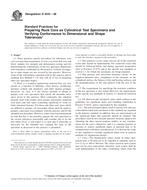
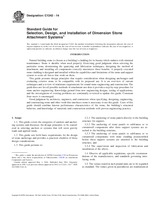 ASTM C1242-14
ASTM C1242-14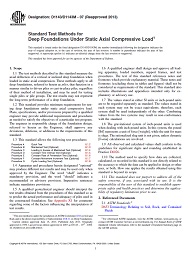 ASTM D1143/D1143M-07..
ASTM D1143/D1143M-07..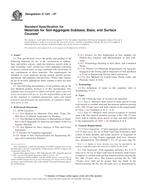 ASTM D1241-07
ASTM D1241-07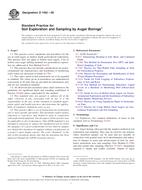 ASTM D1452-09
ASTM D1452-09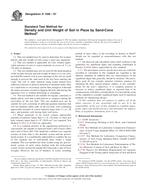 ASTM D1556-07
ASTM D1556-07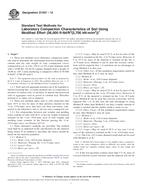 ASTM D1557-12
ASTM D1557-12
 Cookies
Cookies
